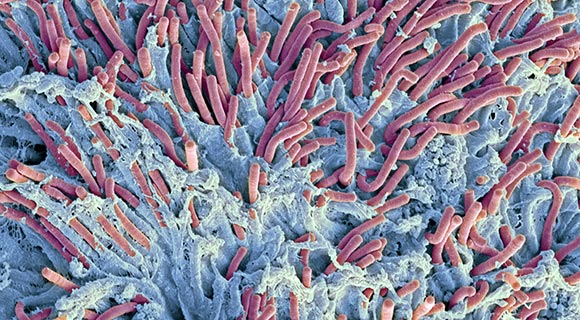To each his own mouth content

Bacteria dominate the microbiota in your mouth, as in the rest of your body. Approximately ten billion bacteria, divided among 700 different species, live in your mouth. Just like every other microbiome, every person has unique mouth microbiota. The composition is dependent upon diet, age, acidity (pH) and your saliva.
A healthy mouth
Microbes in a healthy mouth are widely diverse. In addition to the useful kinds, your mouth is full of bad bacteria that damage your tooth enamel, cause gingivitis or give you smelly breath. Breathing and eating bring a lot of microbes into your mouth. Luckily, they rarely cause problems. There is actually a balance in your mouth. Healthy mouth bacteria suppress the harmful ones and prevent damage. Healthy bacteria neutralise the acids in plaque bacteria, for one thing. And that prevents cavities. Inaddition, they help your immune system keep your body healthy.
Cavities
In general, there are two types of habitats in your mouth: the hard teeth and the soft tissue in the rest of your mouth. Since these two habitats are so different, the microbial populations that live on them are also vastly different. The hard surface of the teeth barely changes at all, unlike the soft tissue where saliva, mucous and cells are renewed on a regular basis.
If you eat a lot of candy, your mouth fills up with large amounts of sugar. That’s a real bacteria magnet. The number of (bad) mouth bacteria increases, and begins to break down the sugars. No simple task. It forces the bacteria to work together. They crawl up close to each other on your teeth and form a thin layer: a biofilm. We call it plaque.

Dental plaque is the ideal place for harmful bacteria.
One of the most notorious plaque bacteria is Streptococcus mutans. As it breaks down sugars, this bacterium makes acids that dissolve tooth enamel and cause cavities.
Bacteria’s neighbours
There are many other microbes in your mouth besides bacteria. Like different kinds of amoebas that feed on bacteria between your teeth. Or methane-producing archaea called methanogens. These are often found in inflamed areas. It is not clear, however, whether they cause the inflammation, or if they just like to settle in inflamed tissue.
One of the most well-known (mouth) fungi is Candida albicans, an opportunistic pathogen. This fungus is harmless in a healthy mouth. But if it gets the upper hand, a fungal infection called thrush (or candidiasis) breaks out. This can happen, for example, if you take antibiotics. The medicine kills the helpful (mouth) bacteria and gives Candida a chance to rise up.

The yeast Candida albicans. Magnified 4,000 times in this picture.
The largest population in your mouth is actually not bacteria, but viruses. There are ten times as many bacterial viruses, or bacteriophages, in your mouth than there are bacteria. Some scientists believe that bacteriophages help your immune system maintain balance in your mouth by killing bacteria.
